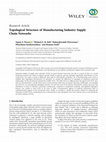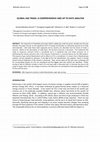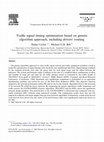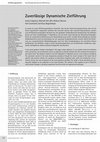Papers by Professor Michael GH Bell

Complexity, 2018
Empirical analyses of supply chain networks (SCNs) in extant literature have been rare due to sca... more Empirical analyses of supply chain networks (SCNs) in extant literature have been rare due to scarcity of data. As a result, theoretical research have relied on arbitrary growth models to generate network topologies supposedly representative of real-world SCNs. Our study is aimed at filling the above gap by systematically analysing a set of manufacturing sector SCNs to establish their topological characteristics. In particular, we compare the differences in topologies of undirected contractual relationships (UCR) and directed material flow (DMF) SCNs. The DMF SCNs are different from the typical UCR SCNs since they are characterised by a strictly tiered and an acyclic structure which does not permit clustering. Additionally, we investigate the SCNs for any self-organized topological features. We find that most SCNs indicate disassortative mixing and power law distribution in terms of interfirm connections. Furthermore, compared to randomised ensembles, self-organized topological feat...

Energy Policy, 2016
the importance of liquefied natural gas (LNG) is rising as demand for it grows rapidly and steadi... more the importance of liquefied natural gas (LNG) is rising as demand for it grows rapidly and steadily due to growth in energy demand, the transition to a low carbon economy and the longer distances over which natural gas is now traded. Given its importance, this work proposes an optimization model that assists to decide on when and where LNG should be delivered by coordinating tanker type, assignment and routing, inventory management, contract obligations, arbitrage and uncommitted LNG. The model maximizes the profit mainly by taking advantage of price differences between different markets. The contributions of this work are twofold. First, following the analysis of expenses and revenues, a new mixed integer programming model for LNG liquefaction and shipping is proposed from a corporate finance perspective. Furthermore, a solution approach for it is implemented and tested. Second, the model is used to derive a short term trade policy for the Middle Eastern LNG producers regarding the spot sale of their uncommitted product to Japan or to the UK, namely to: dispatch to whichever market has the higher current spot price, regardless of the variability of the transport expenses.

Maritime Economics & Logistics, 2017
the importance of liquefied-natural-gas (LNG) in global gas trade has grown steadily over the pas... more the importance of liquefied-natural-gas (LNG) in global gas trade has grown steadily over the past decades; the paper focuses on this significant form of energy and provides an exhaustive portrait of its trade internationally. LNG trade flows both regionally and by country are described and the future of trade is forecast. Based on the description of trade flows, the business structure is discussed. The traditional LNG trade on long-term contracts (LTCs) is considered and it is explained how vital these contracts are in distributing the volume and price risks in the industry, furthermore, in securing finance for the LNG projects. The essence of gas market liberalization and its effect on LTCs is considered, it is shown that in liberalized gas markets, risk has migrated to upstream. In the light of this risk redistribution, the suppliers' intent in moving toward vertical integration of the industry is discussed. Next, various types of LNG spot sale in arbitrage and for uncommitted product to LTCs are considered and the biggest spot sale markets are identified. Finally, pricing of LNG for different markets in both LTCs and spot sales is discussed and it is forecast that due to the surge of supply rather than any change in oil prices, the LNG prices are anticipated to decrease globally at least for the next five years.

Pedestrian and Evacuation Dynamics 2012, 2013
Urban design is moving towards space sharing in order to increase the community texture and safet... more Urban design is moving towards space sharing in order to increase the community texture and safety of street surroundings. However, there is a need for a simulation tool capable of representing future shared space schemes to help judging the designs under which shared space design is a suitable alternative to traditional street designs. This paper presents a microscopic mathematical model that is used a traffic simulation tool capable to represem main behaviors of pedestrians and cars in any shared space layout. This is achieved by generating a route map which helps agents to find the shortest path towards their target destinations on the strategic level. On the operational level, the Social Force Model (SFM) is used and extended for a mixed traffic to produce feasible trajectories. The trajectory results are presented to give a face-validation of the functionality of the shared space simulation model.

Transportation Research Part B: Methodological, 2004
The genetic algorithm approach to solve traffic signal control and traffic assignment problem is ... more The genetic algorithm approach to solve traffic signal control and traffic assignment problem is used to tackle the optimisation of signal timings with stochastic user equilibrium link flows. Signal timing is defined by the common network cycle time, the green time for each signal stage, and the offsets between the junctions. The system performance index is defined as the sum of a weighted linear combination of delay and number of stops per unit time for all traffic streams, which is evaluated by the traffic model of TRANSYT [User guide to TRANSYT, version 8, TRRL Report LR888, Transport and Road Research Laboratory, Crowthorne, 1980]. Stochastic user equilibrium assignment is formulated as an equivalent minimisation problem and solved by way of the Path Flow Estimator (PFE). The objective function adopted is the network performance index (PI) and its use for the Genetic Algorithm (GA) is the inversion of the network PI, called the fitness function. By integrating the genetic algorithms, traffic assignment and traffic control, the GATRANSPFE (Genetic Algorithm, TRANSYT and the PFE), solves the equilibrium network design problem. The performance of the GATRANSPFE is illustrated and compared with mutually consistent (MC) solution using numerical example. The computation results show that the GA approach is efficient and much simpler than previous heuristic algorithm. Furthermore, results from the test road network have shown that the values of the performance index were significantly improved relative to the MC.
Transportation Research Part B: Methodological, 2002

Journal of Advanced Transportation, 2004
This study deals with the sensitivity analysis of an equilibrium transportation networks using ge... more This study deals with the sensitivity analysis of an equilibrium transportation networks using genetic algorithm approach and uses the bi-level iterative sensitivity algorithm. Therefore, integrated Genetic Algorithm-TRANSYT and Path Flow Estimator (GATPFE) is developed for signalized road networks for various level of perceived travel time in order to test the sensitivity of perceived travel time error in an urban stochastic road networks. Level of information provided to drivers correspondingly affects the signal timing parameters and hence the Stochastic User Equilibrium (SUE) link flows. When the information on road system is increased, the road users try to avoid conflicting links. Therefore, the stochastic equilibrium assignment concept tends to be user equilibrium. The GATPFE is used to solve the bi-level problem, where the Area Traffic Control (ATC) is the upper-level and the SUE assignment is the lower-level. The GATPFE is tested for six-junction network taken from literature. The results show that the integrated GATPFE can be applied to carry out sensitivity analysis at the equilibrium network design problems for various level of information and it simultaneously optimize the signal timings (i.e. network common cycle time, signal stage and offsets between junctions).

2008 First International Conference on Infrastructure Systems and Services: Building Networks for a Brighter Future (INFRA), 2008
Incidents whose frequencies are unknown cause a large part of the unreliability of road networks.... more Incidents whose frequencies are unknown cause a large part of the unreliability of road networks. Especially risk-averse road users avoid the possibility of large travel times under a disruption. This paper proposes a traffic assignment which accounts for risk-averseness. Scenarios for all possible disruptions are simulated. The risk-averseness of a user is generalized in a two-parameter route choice formulation. Depending on the parameters, users assign a weight on the travel times for each scenario. This is the basis for their route choice. The simulator can handle a traffic flow composed from different user classes simultaneously in the same network. In the presented case study, the link loads depend on the parameter settings of the users. The route choice for a user class also depends on the risk-averseness of the other users in the network. I.

Assessing transport reliability - malevolence and user knowledge, A.J. Nicholson et al Network vu... more Assessing transport reliability - malevolence and user knowledge, A.J. Nicholson et al Network vulnerability - an approach to reliability analysis at the level of national strategic transport networks, G.M. D'Este, M.A.P. Taylor Risk evaluation and management - a road network reliability study, A.J. Nicholson, E. Dalziell Reliability assessment on searching time for parking in urban areas, W.H.K. Lam, M-L. Tam An evaluation of the reliability of travel time in road networks based on stochastic user equilibrium, H. Inouye Effect of route choice models on estimation of travel time reliability under demand and supply variations, A. Chen et al Reliability assessment on transit network services, Y. Yin et al Modeling of traveler's uncertainty and anxiety, S. Kikuchi, H.J. van Zuylen Traveller's behaviour under uncertain conditions, H.J. van Zuylen, S. Kikuchi Mode choice model with travel time reliability and commuters' travel behavior before/after a major public transportation service closure, H. Wakabayashi et al An analysis of potential of providing information on traffic accident to enhance travel time reliability, N. Uno et al Drivers' cognition and dynamics of traffic-condition induced by network modification, S. Fujii, R. Kitamura A normative assessment of transport network reliability based on game theory, C. Cassir et al Stochastic network design problem - an optimal link investment model for reliable network, Y. Asakura et al Improving the reliability of street networks in highly densely populated urban areas, Y. Li, H. Tsukaguchi Street network reliability evaluation following the Chi-Chi earthquake, Y-L. Lee, K-Y. Yeh Evaluation of road network reliability considering traffic regulation after a disaster, F. Kurauchi et al Reliable vehicle routing and scheduling with time windows towards city logistics, E. Taniguchi T. Yamada Generalized travel cost reliability in a simple dynamic network under advanced traveler information system, T.H. Lam et al Estimating benefits of travel demand management schemes with uncertainty of travel times, E. Taniguchi, K. Ikeda Simulating road traffic interruptions - does it matter what model we use? Traffic flow analysis on inter-city expressway for emergency situations, K. Ogawa, T. Akiyama Travel time variability after a shock - the case of the twin cities ramp meter shut off, D. Levinson, L. Zhang Effects of demand variation on the location of optimal road pricing cordons, A. Sumalee et al.
Maritime Policy & Management, 2020
Ferry services are an important mode of public transport in a number of large cities with harbour... more Ferry services are an important mode of public transport in a number of large cities with harbours or rivers, including Brisbane and Sydney. The ferry network design problem (FNDP) focuses on finding a network of ferry services to meet the demand for mobility with a good level of service at a reasonable operating cost. An important feature of the FNDP is that the objective behind the design of the ferry services, namely expected passenger utility, is the same as the objective governing the choice of services made by passengers to complete their trips, resulting in a single level network design problem rather than the more conventional bilevel network design problem. This paper presents an entropy maximising framework that solves the utility maximising service choice and the network design problem jointly.

Navigationsgeräte sind mittlerweile ein fast selbstverständlicher Teil des auto mobilen Lebens un... more Navigationsgeräte sind mittlerweile ein fast selbstverständlicher Teil des auto mobilen Lebens und stellen neben dem Verkehrsfunk die wichtigste Informationsquelle im Fahrzeug dar. Vor allem in den letzten Jahren sind neben den fest installierten Geräten auch mobile Navigationsgeräte zu günstigen Preisen am Markt erhältlich. Prognosen zeigen, dass in wenigen Jahren ein großer Teil der Fahrzeuge mit einem Navigationsgerät ausgestattet sein wird. Ziel der reinen Zielführungsfunktion eines Navigationsgerätes ist es, vom aktuellen, meist durch Satellitenortung errechneten, Standpunkt des Fahrzeugs entweder die zeitlich schnellste oder räumlich kürzeste Route zum eingegebenen Bestimmungsort zu finden. Neben der reinen Zielführungsfunktion, die vor allem dem Fahrer in einer ihm unbekannten oder unvertrauten Umgebung hilft, gewinnt die sogenannte „dynamische Zielführung“ immer mehr an Bedeutung. Dabei werden aktuelle Verkehrsinformationen, z. B. per TMC, bei der Routenberechnung berücksich...

In the first chapter of the report, a brief introduction is given on image processing and the com... more In the first chapter of the report, a brief introduction is given on image processing and the components of an image processing system. In chapter two, research on image processing applied to traffic monitoring and control is outlined, including: (1) the traffic research image processing system (trip) developed in the early 198o's for vehicle counting, automatic speed measurement and vehicle tracking computation and (2) the cellular logic image processor (clip) system designed to manipulate digital images at high speed. The latest research is concerned with counting and tracking moving vehicles in real time, utilizing two basic techniques: (a) image segmentation and (b) vehicle tracking. A new computerised system, traffic analysis using low cost image processing (tulip) is described. The system utilizes an IBM personal computer acting as host to the fg-100 image processor. Vehicle count, speed and headway data from video pictures of a traffic scene is collected. Five different segmentation methods can be utilized on tulip: (i) recursive frame differencing; (II) reference frame differencing; (III) reference value differencing; (IV) signed reference value differencing; and (v) pixel pass filter. These methods are reviewed and compared, and results obtained discussed.

Journal of the Eastern Asia Society for Transportation Studies, 2005
This paper proposes a method for evaluating the effect of transit fare systems on passengers'... more This paper proposes a method for evaluating the effect of transit fare systems on passengers' behaviour using a fore-constructed, capacity-constrained, transit assignment model. The optimum fare setting model is formulated as a mathematical programming with equilibrium constraints (MPEC) problem in which passengers are assumed to choose the minimum cost paths where a user equilibrium condition is achieved. Both total cost and connectivity reliability, which is defined here as the probability of arriving at the destination without failing to board at any station, are adopted as the evaluation index of the problem. The equality of the congestion mitigation effect for each OD pair is considered explicitly utilising the idea of the Gini coefficient, which is the economic indicator. The proposed model is solved using NSGA-II (Non-dominated Sorting GA), which is one method for solving a multi-objective optimisation problem. Finally, a numerical example for a simple network is shown.
This paper examines the relationship between traffic flows and travel times on signal controlled ... more This paper examines the relationship between traffic flows and travel times on signal controlled links. The effect of cross flows, via vehicle responsive signal control, is considered. Initial development work has been performed using a microscopic traffic simulator, taking as an example a junction in Pforzheim, Germany, for which the control logic was obtained. The paper concludes by considering the wider use of the travel time functions for network monitoring, in particular incident detection.
ArXiv, 2018
Due to the increasingly complex and interconnected nature of global supply chain networks (SCNs),... more Due to the increasingly complex and interconnected nature of global supply chain networks (SCNs), a recent strand of research has applied network science methods to model SCN growth and subsequently analyse various topological features, such as robustness. This paper provides: (1) a comprehensive review of the methodologies adopted in literature for modelling the topology and robustness of SCNs; (2) a summary of topological features of the real world SCNs, as reported in various data driven studies; and (3) a discussion on the limitations of existing network growth models to realistically represent the observed topological characteristics of SCNs. Finally, a novel perspective is proposed to mimic the SCN topologies reported in empirical studies, through fitness based generative network models.











Uploads
Papers by Professor Michael GH Bell